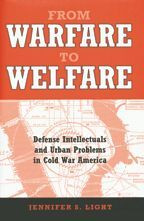
Reviews
Of interest to scholars and students of urban history, planning, geography, and sociology, as well as urban studies more generally... Highly recommended.
A fascinating and suggestive account of the influence of ecology and natural-resource management on academic urbanists, city planners, and real-estate professionals.
Light’s excavation of the intellectual terrain, on which so much of mid-20th-century urban policy rested, significantly contributes to our understanding of planning’s evolution in this critical period following the profession’s foundational years.
An outstanding history of how ecological concerns have shaped urban development around the country.
Light does a wonderful job of tracking the migration of people and ideas to the nation's capital, demonstrating how these shaped the National Resources Planning Board's agenda and actions, and detailing how urban management became national policy from FDR to LBJ.
This engaging and well-written work challenges the notion that cities were seen as 'unnatural' places during the early years of the twentieth century, when the United States was transitioning from an agrarian to an urban society and the professions of social science, urban planning, and real estate were being developed... To understand that policies that led to the bulldozing of neighborhoods in the name of "urban renewal" in the 1960s and 1970s had their origins in theories first espoused in the opening decades of the twentieth century relating to forest and field resource management reminds us that there may well be unintended consequences for seemingly benign theories, models, and approaches promoted today.
Light explores how ecological ideas such as 'climax,' 'blight,' and 'conservation' transferred from the natural sciences to the emerging fields of urban sociology, geography, and economics during the 1920s and were eventually adopted by urban professionals during the 1930s and 1940s. Most importantly, she argues that these ideas—which saw cities as closed ecological communities that, like farms and forests, could be managed scientifically—significantly shaped local and national urban-renewal policy in postwar America... This book makes an important contribution to the study of twentieth century American cities.
A model for anyone looking to reveal the complex ways that scientific thinking plays into the emergence of an entire field of social planning.
An interesting, erudite, and important book. It describes the evolution of the urban professions (academic social scientists, real estate professionals, and urban planners) from 1920 to 1960 and combines prodigious scholarship with a strong thesis, and very deftly explores the relationship between the local and the national—a great contribution.
Book Details
Acknowledgments
Introduction: Revisiting American Antiurbanism
1. The City Is an Ecological Community
2. The City Is a National Resource
3. A Life Cycle Plan for Chicago
4. From Natural Law to State Law
5
Acknowledgments
Introduction: Revisiting American Antiurbanism
1. The City Is an Ecological Community
2. The City Is a National Resource
3. A Life Cycle Plan for Chicago
4. From Natural Law to State Law
5. A Nation of Renewable Cities
Conclusion: From Ecology to System
Notes
Essay on Sources
Index




